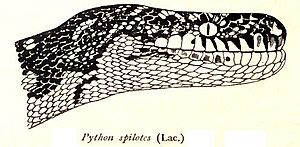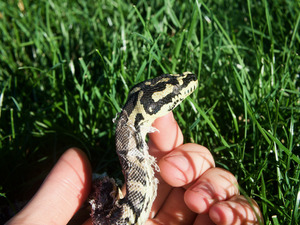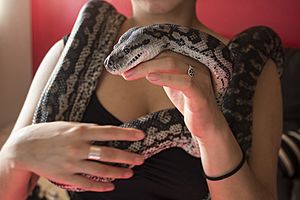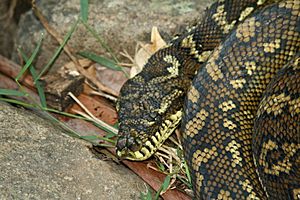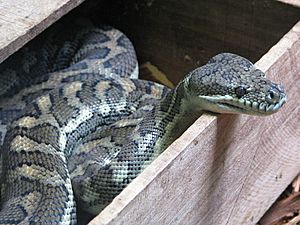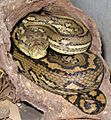Carpet python facts for kids
Quick facts for kids Carpet python |
|
|---|---|
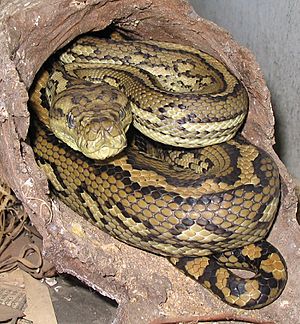 |
|
| Conservation status | |
| Scientific classification | |
| Genus: |
Morelia (snake)
|
| Species: |
spilota
|
The Morelia spilota, often called the carpet python or diamond python, is a large snake from the python family. You can find these snakes in Australia, New Guinea (which includes parts of Indonesia and Papua New Guinea), the Bismarck Archipelago, and the northern Solomon Islands. There are many different types, or subspecies, of the carpet python. Different groups list between six and eight known subspecies.
Contents
About the Carpet Python
Carpet pythons are big snakes. They usually grow to be about 2 to 4 m (6.6 to 13.1 ft) long, which is like 6 to 13 feet. They can weigh up to 15 kg (33 lb), or about 33 pounds. The largest type, M. s. mcdowelli, often reaches 2.7–3 m (8.9–9.8 ft) (9 to 10 feet). The smallest type, M. s. variegata, is usually 120–180 cm (3.9–5.9 ft) (4 to 6 feet) long. On average, an adult carpet python is about 2 m (6.6 ft) (6.5 feet) long.
Male carpet pythons are usually smaller than females. In some places, females can be up to four times heavier! Their head is shaped like a triangle. They have special pits on their lips that can sense heat. This helps them find warm-blooded prey in the dark.
The colors of carpet pythons can be very different. They range from olive green to black, with white, cream, or gold markings. Their patterns might look like diamonds or have fancy designs made of light and dark bands on a gray or brown background.
How They Reproduce
Carpet pythons lay eggs. Females lay between 10 and 50 eggs at a time. After laying the eggs, the mother snake coils around them. She protects them and keeps them warm by twitching her muscles to create heat. This special way of caring for eggs is common for pythons. The mother stops caring for the eggs once the baby snakes hatch.
What They Do
Carpet pythons can be active during the day and night. However, one type, M. s. variegata, is mostly active at night. Carpet pythons like to live in trees, but they also spend time in open areas to warm themselves in the sun.
What They Eat
Carpet pythons kill their prey by squeezing it tightly. This is called constriction. They mainly eat small mammals, birds, and lizards. Sometimes, they have even been known to eat pet cats and small dogs.
Where They Live
You can find carpet pythons all over mainland Australia, except for the very dry central and western parts. They live in many different places, from the rainforests of northeastern Queensland to woodlands and even dry islands. They are often found near people's homes. Here, they are helpful because they eat rats and other pests. Carpet pythons can even live in areas where it snows! They are good at climbing trees but can also move around on the ground. They also live in grasslands that have hot and dry weather.
Conservation Status
Overall, the carpet python species is not in danger. However, one specific type, M. s. spilota, is considered threatened in Victoria. Another type, M. s. imbricata, is almost threatened in Western Australia. This is because they are losing their natural homes.
Carpet Pythons as Pets
Carpet pythons are popular pets for snake lovers. Some types, like M. s. mcdowelli and M. s. variegata, can be a bit grumpy when they are young. But types like M. s. spilota and M. s. metcalfei are usually calmer. Even though they can grow quite large (2.0 to 3.5 m (6.6 to 11.5 ft) or 6.5 to 11.5 feet), most become gentle adults.
You need to be careful when feeding them. They have a very strong "feeding response," which means they get excited about food. This can sometimes be mistaken for aggression. Pet carpet pythons are usually fed live or frozen (then thawed) rats. They can live for 15 to 20 years.
The general care for all carpet pythons is similar. However, the diamond python (M. s. spilota), which lives in colder areas, has some slightly different needs.
Types of Carpet Pythons (Subspecies)
Here are some of the different types of carpet pythons and where they live:
| Subspecies | Common name | Where they live |
|---|---|---|
| M. s. cheynei | Jungle carpet python | Australia in northeastern Queensland |
| M. s. mcdowelli | Coastal carpet python | Australia in eastern Queensland and northeastern New South Wales |
| M. s. metcalfei | Inland carpet python | Australia in the Murray-Darling Basin of Queensland, New South Wales, Victoria and South Australia |
| M. s. spilota | Diamond python | Australia in eastern New South Wales and the very east of Victoria |
| M. s. variegata | Darwin carpet python Irian Jaya carpet python Papuan carpet python Rubber python |
New Guinea (Western New Guinea and Papua New Guinea) and Australia in northwestern Western Australia and northern Northern Territory |
Mixed Types (Hybrids)
- Sometimes, carpet pythons can mix with other snakes, like the green tree python.
Naming the Snake
The carpet python was first described in 1804 by a scientist named Lacépède. He first called it Coluber spilotus. Over time, scientists have given it different names and tried to sort out its different types. This has led to many different names being used for the same snake! The common names you hear, like carpet python or diamond python, are used in different regions.
Images for kids
See also
 In Spanish: Pitón de alfombra para niños
In Spanish: Pitón de alfombra para niños



